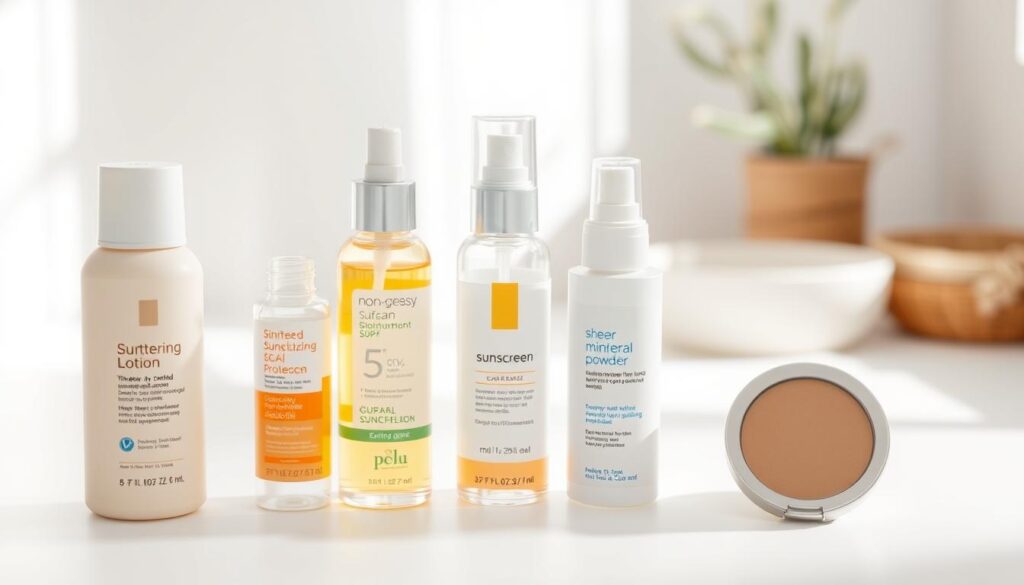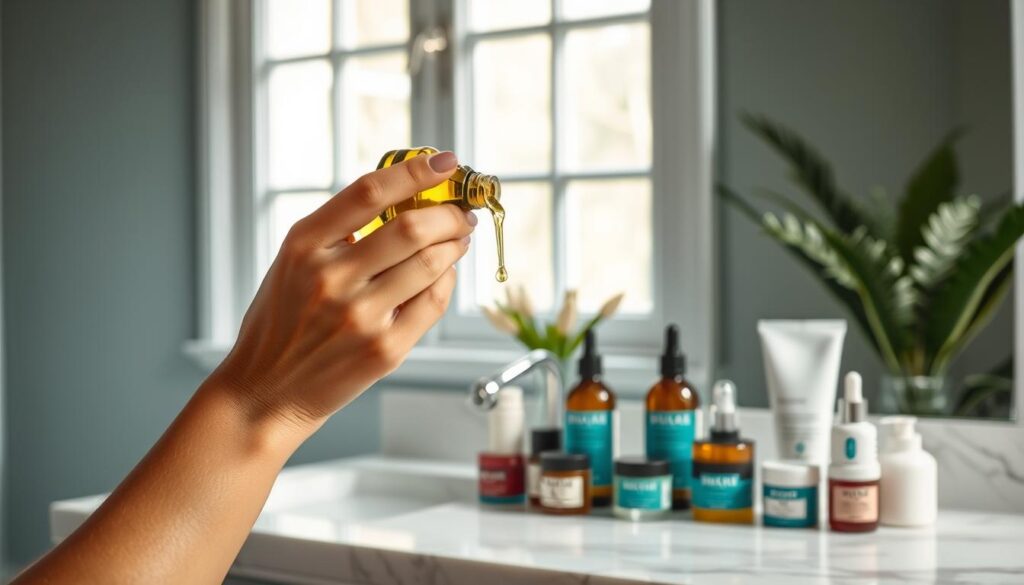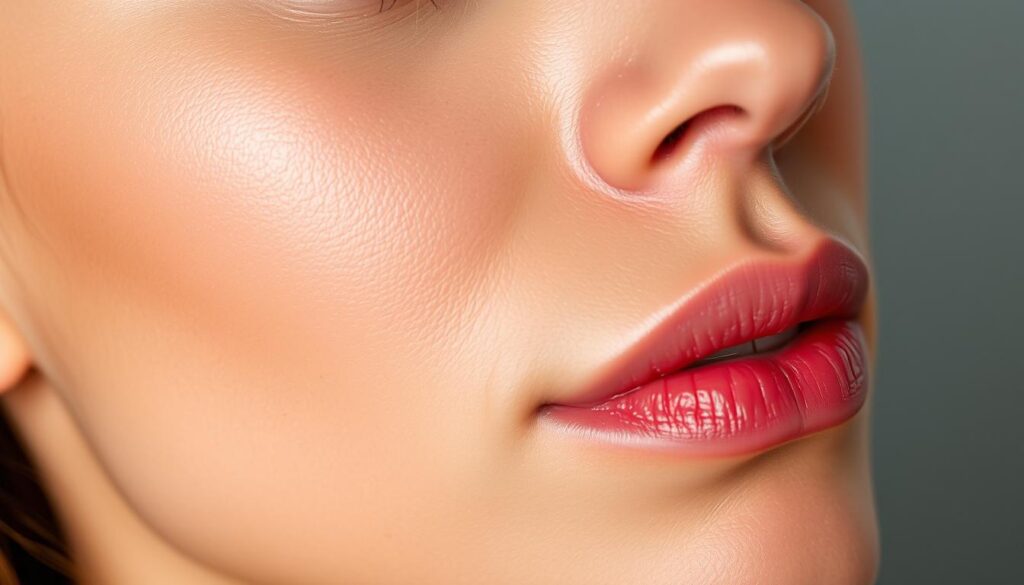Dealing with a shiny face can feel frustrating, but understanding oil production is the first step to balance. Many people experience this issue, especially during hormonal changes like adolescence. It’s a common concern that can lead to breakouts and an uneven complexion1.
A consistent routine can help control excess oil and keep your face looking fresh. Cleansing twice daily is essential to remove buildup and maintain hydration. Using gentle, targeted products ensures your skin stays healthy without stripping away natural moisture2.
Experts recommend incorporating ingredients like salicylic acid or niacinamide to regulate sebum levels. These can refine pores and reduce shine, giving you a smoother appearance. With the right approach, you can achieve a balanced, radiant look every day.
Understanding the Basics of Oily Skin
Excess oil on your face doesn’t have to be a mystery—let’s break it down. This condition often stems from overactive sebaceous glands, which produce sebum, a natural oil that keeps your skin hydrated. When these glands work overtime, your complexion can appear shiny and slick, sometimes leading to larger pores and breakouts3.
What Defines Oily Skin?
Oily skin is characterized by a persistent shine, especially in the T-zone (forehead, nose, and chin). This happens because sebaceous glands produce more sebum than necessary. Genetics and hormonal changes, like puberty, often play a role4.
Your skin’s texture may also feel thicker, and pores can appear more visible. While this might seem frustrating, it’s important to remember that sebum is essential for maintaining hydration and protecting your skin barrier.
Myths and Facts About Excess Oil
There are many misconceptions about oily skin. One common myth is that it doesn’t need moisturizing. In reality, skipping hydration can lead to even more oil production as your skin tries to compensate3.
Another myth is that oily skin is caused by poor hygiene. While cleansing is important, over-washing can strip your skin of its natural oils, leading to irritation and imbalance. Instead, focus on gentle, consistent care.
| Myth | Fact |
|---|---|
| Oily skin doesn’t need moisturizer. | Hydration is crucial to balance oil levels. |
| Over-washing reduces oiliness. | Over-washing can irritate and increase oil production. |
| Oily skin is only a teenage issue. | It can affect people of all ages due to genetics and hormones. |
Understanding these basics helps you choose the right products and routines. With the right approach, you can manage your complexion effectively and keep it looking fresh and balanced.
Factors That Contribute to Excess Oil Production
Your skin’s oil levels are influenced by a mix of internal and external factors. Understanding these can help you manage your complexion more effectively. Let’s explore what drives sebum overproduction and how you can address it.
Hormonal Changes and Genetics
Hormones play a significant role in oil production. During puberty, androgens like testosterone stimulate sebaceous glands, leading to higher sebum levels5. Women may also notice changes during ovulation or hormonal shifts, which can increase oiliness6.
Genetics also contribute. If your parents had oily skin, you’re more likely to experience it too. Studies show that nearly 50% of variability in sebum production is genetic6.
Diet, Climate, and Lifestyle Influences
What you eat can impact your skin. Diets high in dairy, unhealthy fats, or sugary foods are linked to increased oil production7. A 2019 study found that consuming more meat, dairy, and alcohol correlated with higher sebum levels7.
Climate matters too. Humid weather can trigger excess oil, while dry conditions might lead to dehydration6. Lifestyle habits, like stress or lack of sleep, can also worsen the issue6.
By understanding these factors, you can tailor your skin care routine and make lifestyle adjustments for a more balanced look.
Oily Skin: Causes and Best Skincare Routine
A shiny T-zone and persistent breakouts are common struggles for many. These issues often stem from overactive sebaceous glands, which produce excess oil. This can lead to enlarged pores and an uneven complexion8.
One of the biggest challenges is managing acne. Excess oil can clog pores, leading to frequent breakouts. Enlarged pores, especially in the T-zone, are another common concern that many face9.
Fortunately, a targeted routine can help. Experts recommend using products with ingredients like salicylic acid or niacinamide. These regulate oil production and refine pores, giving your skin a smoother appearance8.
Key Issues and Solutions
Here’s a quick look at the most common concerns and how to address them:
| Issue | Solution |
|---|---|
| Persistent Acne | Use products with salicylic acid to unclog pores8. |
| Enlarged Pores | Incorporate niacinamide to refine and tighten9. |
| Shiny Complexion | Opt for oil-free, mattifying products8. |
By understanding these concerns, you can create a routine that works for you. The right combination of products and techniques will help control oil and prevent breakouts, setting the stage for healthier-looking skin.
Step-by-Step Guide to Cleansing and Exfoliating
Cleansing and exfoliating are essential steps for a fresh, balanced face. These practices remove dirt, makeup, and excess oil, setting the stage for a healthy routine. Let’s break down how to do it right.
Morning and Evening Cleansing Techniques
Start your day by washing your face with a gentle cleanser. This removes overnight buildup and preps your skin for the day ahead. In the evening, double-cleanse to ensure all impurities are gone10.
Choose a cleanser that works without stripping your skin’s natural moisture. Look for products with a neutral pH to avoid irritation11. This step is crucial for maintaining balance and preventing overproduction of oil.
Choosing the Right Exfoliating Products
Exfoliation helps unclog pores and promotes cell turnover. Use a product with ingredients like salicylic or glycolic acid for best results12. These refine your texture and reveal smoother, clearer skin.
Limit exfoliation to 2-3 times a week to avoid irritation. Overdoing it can lead to sensitivity and disrupt your skin’s natural barrier12. Always follow up with hydration to keep your complexion healthy.
By mastering these steps, you’ll create a routine that keeps your face fresh and balanced all day long.
Perfecting the Use of Toners, Serums, and Treatments
Toners, serums, and treatments are essential tools for managing shine and refining pores. These products work together to balance your complexion and address specific concerns like excess oil and breakouts. By understanding their roles, you can create a routine that keeps your face fresh and clear.
Key Ingredients for a Balanced Complexion
A toner is your first step after cleansing. It restores your skin’s pH balance and minimizes the appearance of pores. Look for products with salicylic acid or glycolic acid, which help unclog pores and remove dead skin cells13.
Serums, particularly those with niacinamide, are excellent for controlling oil production. This ingredient brightens your complexion and reduces shine, making it a must-have in your skin care arsenal14.
How to Incorporate Targeted Treatments
Treatments like Paula’s Choice Pore-Reducing Toner or The INKEY List Niacinamide Oil Control Serum can address acne and improve texture. These products are designed to target specific concerns, ensuring your face stays balanced throughout the day15.
Always apply your toner first, followed by a serum and treatment. This order allows each product to penetrate effectively and deliver maximum benefits. With the right approach, you can achieve a smoother, more radiant look.
Lightweight Moisturizing and Sun Protection Strategies
Keeping your face hydrated and protected doesn’t have to mean adding extra shine. Even if your skin tends to produce more oil, it still needs hydration to stay balanced. The right moisturizer and sunscreen can help you achieve this without clogging pores or leaving a greasy finish.

Selecting Oil-Free, Hydrating Moisturizers
Choosing a moisturizer for oily types can be tricky. Look for oil-free formulas that provide hydration without heaviness. Ingredients like hyaluronic acid are excellent for locking in moisture without adding shine16.
Products like CeraVe PM Facial Moisturizing Lotion are lightweight and non-comedogenic, making them ideal for daily use. They help maintain your skin’s natural barrier while keeping it hydrated17.
Effective Sunscreen Options for a Matte Finish
Daily sun protection is a must, but not all sunscreens are created equal. For oily types, opt for formulas that offer a matte finish and won’t clog pores. Look for products with at least SPF 30 and lightweight textures16.
SkinCeuticals Physical Matte UV Defense SPF 50 is a top choice, offering broad-spectrum protection without leaving a greasy residue. It’s perfect for keeping your skin safe and shine-free throughout the day17.
| Product | Key Benefit |
|---|---|
| CeraVe PM Facial Moisturizing Lotion | Lightweight, non-comedogenic hydration |
| SkinCeuticals Physical Matte UV Defense SPF 50 | Matte finish, broad-spectrum protection |
By incorporating these products into your routine, you can keep your skin hydrated and protected without compromising on comfort or appearance.
Do’s and Don’ts for Caring for Oily Skin
Taking care of your complexion doesn’t have to be overwhelming—simple steps can make a big difference. By focusing on the right habits and products, you can control excess oil and maintain a fresh, balanced look. Let’s explore the best practices and common pitfalls to avoid.
Product Choices and Application Tips
Choosing the right products is key to managing shine and preventing breakouts. Opt for gentle cleansers and non-comedogenic formulas that won’t clog pores. Ingredients like salicylic acid and niacinamide are excellent for refining texture and reducing oiliness18.
When applying makeup, use lightweight, oil-free products. Heavy foundations can trap oil and lead to breakouts. Instead, try a mattifying primer to keep your face shine-free throughout the day19.
Here’s a quick guide to help you make informed choices:
| Do’s | Don’ts |
|---|---|
| Use blotting papers to absorb excess oil gently19. | Avoid harsh scrubs that can irritate and increase oil production18. |
| Cleanse after sweating to remove impurities20. | Skip heavy creams that can clog pores and worsen shine19. |
| Incorporate a mattifying moisturizer to balance hydration18. | Don’t over-wash, as it can strip natural moisture and trigger more oil20. |
Lifestyle habits also play a role in maintaining a healthy complexion. Stay hydrated, manage stress, and wash your pillowcases regularly to reduce acne flare-ups18. With the right approach, you can achieve a fresh, matte look every day.
Expert Tips and Natural Solutions for Oily Skin Management
Managing excess oil doesn’t have to be complicated—natural solutions can make a difference. Combining expert advice with simple home remedies can help you achieve a balanced, fresh look. Let’s explore how you can enhance your routine with these effective strategies.
Home Remedies and Natural Ingredients
Natural ingredients like honey and oatmeal are excellent for soothing irritation and reducing shine. Honey has antibacterial properties that help manage acne, while oatmeal calms the skin and improves texture21. Clay masks, especially those with kaolin or bentonite, absorb excess oil and refine pores, leaving your face feeling refreshed22.
Fermented rice water is another popular remedy. It acts as a natural toner, balancing your skin’s pH and reducing oiliness. These ingredients are gentle yet effective, making them ideal for daily use23.
Advice from Dermatologists and Estheticians
Experts like Sandra Lee and Natalia Spierings emphasize the importance of a balanced routine. They recommend using serums with niacinamide to regulate oil production and strengthen the skin’s barrier21. Retinoids are also beneficial for refining texture and preventing clogged pores23.
Over-cleansing can strip your skin of its natural oils, leading to increased oil production. Instead, cleanse twice daily and follow up with a lightweight moisturizer to maintain hydration22. This approach ensures your skin stays healthy and balanced.
By integrating natural remedies with expert-recommended products, you can create a synergistic effect for healthier, more radiant skin. Whether you prefer home treatments or professional solutions, these tips will help you manage oil effectively.
Conclusion
Achieving a balanced, matte look is within reach with the right approach. Consistency is key to managing excess oil and maintaining a fresh complexion. A well-rounded routine—cleansing, exfoliating, and moisturizing—helps control shine and prevent breakouts24.
Using products with ingredients like salicylic acid and niacinamide can refine pores and regulate oil production25. Don’t forget sun protection; lightweight, non-comedogenic formulas keep your appearance shine-free while safeguarding your skin26.
Tailor your care to your lifestyle, and remember that small changes make a big difference. With the right knowledge and products, you can keep skin healthy and radiant over time. Start refining your routine today for long-term success!



